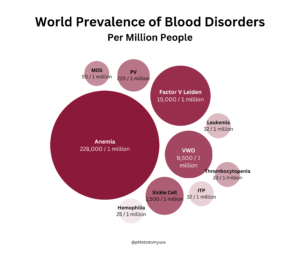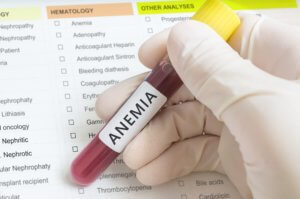16 Jan Exploring Blood Disorders, From Common to Rare
Blood disorders can have a profound impact on our overall health and well-being. This guide will explore ten blood disorders, ranging from the most common to the rarest. We will delve into each disorder’s symptoms and available treatment options, providing insights into their potential dangers.
1. Anemia
Anemia is a widespread blood disorder characterized by a deficiency of red blood cells or low hemoglobin levels. It is relatively common and can result from various factors, including nutritional deficiencies, chronic illnesses, or genetics. There are many types of anemia, each with its distinct causes. However, most will have similar symptoms. In severe cases, anemia can damage organs and impair cognitive function.
Symptoms: Common symptoms include persistent fatigue, weakness, pale skin, shortness of breath, dizziness, and cold hands and feet.
Treatment: Treatment often involves iron supplements, dietary changes to include iron-rich foods, and addressing the underlying cause.
2. Leukemia
Leukemia is a type of blood cancer marked by the uncontrolled growth of abnormal white blood cells. It can be acute or chronic, and there are different types of leukemia. Consequently, it is a prevalent cancer with specific types affecting different age groups. For example, acute lymphoblastic leukemia primarily impacts children, while acute myeloid leukemia occurs in both children and older adults. Leukemia can be life-threatening if left untreated.
Symptoms: Fatigue, frequent infections, easy bleeding, and bruising are common signs of leukemia. Other symptoms may include unexplained weight loss, night sweats, and bone pain.
Treatment: Treatment includes chemotherapy, radiation therapy, targeted therapies, and, in some cases, bone marrow transplantation.
3. Sickle Cell Disease
Sickle cell disease is a genetic disorder that causes red blood cells to become rigid and crescent-shaped. As a result, blockages in small blood vessels can occur. Sickle cell disease is relatively common in regions with a high prevalence of malaria, such as Africa, the Middle East, and India. This disease is generally considered a lifelong condition and can lead to reduced life expectancy if not managed.
Symptoms: Individuals with sickle cell experience pain, anemia, organ damage, susceptibility to infections, and possibly stroke or acute chest syndrome.
Treatment: Management includes pain relief, blood transfusions, medications to prevent complications, and, in some cases, stem cell transplantation.
4. Thrombocytopenia
Thrombocytopenia results from a shortage of platelets. As a result, easy bruising and prolonged bleeding can occur. Various underlying conditions can cause it. Thrombocytopenia is less common than some other blood disorders. Untreated cases can lead to severe and life-threatening bleeding episodes. For example, bleeding within the brain or gastrointestinal bleeding is possible.
Symptoms: Nosebleeds, petechiae (small red spots), excessive bruising, and, in severe cases, internal bleeding.
Treatment: Treatment options depend on the underlying cause and may include medication to boost platelet production or transfusions.
5. Idiopathic Thrombocytopenic Purpura
ITP is an autoimmune disorder where the immune system mistakenly destroys platelets, leading to a low platelet count. While ITP is relatively rare, it can affect individuals of all ages, including children and adults. If left untreated, ITP can lead to an increased risk of severe bleeding, including internal bleeding. Consequently, ITP can be life-threatening.
Symptoms: Bruising, petechiae, nosebleeds, and, in severe cases, internal bleeding.
Treatment: Management depends on the severity and may involve treatments such as medication, removal of the spleen, or other immune-modulating therapies.
 6. Myelodysplastic Syndromes
6. Myelodysplastic Syndromes
MDS encompasses a group of blood disorders characterized by bone marrow dysfunction, which affects the production of healthy blood cells. The prevalence of MDS varies, with some subtypes more commonly diagnosed in older adults, particularly those over 60. However, MDS can affect people of all age groups. MDS can progress to acute leukemia if left untreated.
Symptoms: Fatigue, anemia, and a higher risk of infections are common among individuals with MDS. Some individuals may also develop bleeding or bruising problems.
Treatment: Treatment varies based on the type and severity of MDS. For example, supportive care, transfusions, medications, and stem cell transplantation are all options.
7. Von Willebrand Disease
Von Willebrand disease is an inherited bleeding disorder affecting clotting. VWD is relatively rare, estimated to affect about 1% of the general population. Additionally, severe cases of untreated VWD can result in joint and soft tissue bleeding, which may lead to chronic joint damage.
Symptoms: Common VWD symptoms may include easy bruising, prolonged bleeding from minor wounds or surgeries, and nosebleeds.
Treatment: Management involves medications to enhance clotting and lifestyle adjustments.
8. Factor V Leiden
Factor V Leiden is a genetic mutation that increases the risk of abnormal blood clot formation. Specifically, it involves resistance to the anticoagulant effects of protein C, a natural inhibitor of blood clot formation. While Factor V Leiden is relatively uncommon, it is the most common in people of European descent. Factor V Leiden can cause a higher risk of developing abnormal blood clots, known as venous thromboembolism (VTE).
Symptoms: Factor V Leiden is a genetic risk factor rather than a blood disorder with specific symptoms.
Treatment: Management may involve blood thinners and lifestyle changes to reduce the risk of clotting.
9. Hemophilia
Hemophilia is a hereditary condition that impairs the blood’s clotting ability, leading to prolonged bleeding. While hemophilia is relatively rare, it is one of the most well-known hereditary bleeding disorders. It primarily affects males, as it is an X-linked genetic condition. If left untreated or undiagnosed, hemophilia can result in potentially life-threatening bleeding episodes. Spontaneous bleeding into soft tissues can also occur, leading to chronic joint damage and reduced mobility.
Symptoms: In addition to prolonged bleeding, individuals with hemophilia may experience joint pain, swelling, and spontaneous bleeding.
Treatment: Clotting factor replacement therapy is the primary treatment for hemophilia.
10. Polycythemia Vera
Polycythemia vera is a condition where the bone marrow produces too many red blood cells, leading to blood clots. It is rare, with an estimated incidence of around 44 to 57 per 100,000 people in the US. It most commonly occurs in adults, with the average age in the 60s. If left untreated, PV can lead to an increased risk of blood clots. These clots can result in complications such as stroke, heart attack, deep vein thrombosis, and pulmonary embolism. Additionally, PV can cause enlargement of the spleen.
Symptoms: Symptoms may include fatigue, itching (especially after a warm bath or shower), headaches, and risk of blood clots.
Treatment: Treatment typically involves regular blood removal (phlebotomy), medications to reduce blood cell production, and managing blood clot risk factors.
Conclusion
In conclusion, understanding these blood disorders is essential for recognizing their symptoms and seeking appropriate treatment. If you suspect you have a blood disorder, consult a healthcare professional for a proper diagnosis. In sum, early intervention and proper care can improve the quality of life for affected individuals.

